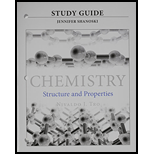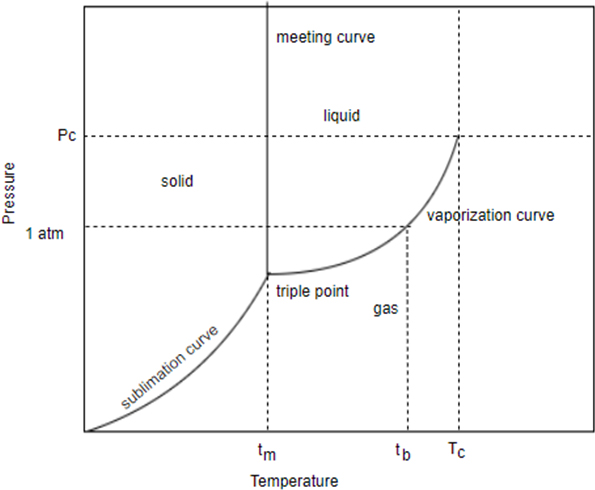
Interpretation:

Solid: Solid is a sample of matter that retains its shape and density when not confined. Stronger forces of attraction exist between atom/ions/ molecules.
Liquid: A liquid is a sample of matter that conforms to shape of container in which acquires a defined surface in the presence of gravity. In this state weaker force exist between atoms/ ions/ molecules.
Gas: A gas is a sample of matter that conforms to the shape of container in which it is placed and acquires whole volume of container.
Negligible forces of attraction exist between atoms/ions/molecules.
Supercritical fluid: Fluid over its critical temperature and pressure exhibiting good solvent power.
Boling point: The boiling point of a substance is the temperature at which the vapour pressure of the liquid equal the pressure surrounding the liquid and liquid change in vapour
Normal point: The normal boiling point of a substance is defined as the temperature at which the vapour pressure of the liquid becomes equal to at the sea level.
Concept introduction:

This is the generic phase diagram. This graph show phase change as a function of temperature and pressure.
To determine:
Nitrogen has normal Boiling point at and a melting point of its critical temperature is and its critical pressure is torr it has triple point at and torr sketch the phase diagram for nitrogen. Does nitrogen have a stable liquid state at
Want to see the full answer?
Check out a sample textbook solution
Chapter 13 Solutions
Study Guide For Chemistry: Structure And Properties
- The vapor pressure of ethanol, C2H5OH, at 50.0 C is 233 mmHg, and its normal boiling point at 1 atm is 78.3 C. Calculate the vapH of ethanol.arrow_forward8.48 Why must the vapor pressure of a substance be measured only after dynamic equilibrium is established?arrow_forwardKrypton, Kr, has a triple point at 169C and 133 mmHg and a critical point at 63C and 54 atm. The density of the solid is 2.8 g/cm3, and the density of the liquid is 2.4 g/cm3. Sketch a rough phase diagram of krypton. Circle the correct word in each of the following sentences (and explain your answers). a Solid krypton at 130 mmHg (melts, sublimes without melting) when the temperature is raised. b Solid krypton at 760 mmHg (melts, sublimes without melting) when the temperature is raised.arrow_forward
- Consider the following data for xenon: Triple point: 121C, 280 torr Normal melting point: 112C Normal boiling point: 107C Which is more dense, Xe(s) or Xe(l)? How do the melting point and boiling point of xenon depend on pressure?arrow_forwardA pure substance X has the following properties: Mp=90C, increasing slightly as pressure increases; normal bp=120C; liquid vp=65mm Hg at 100C, 20 mm Hg at the triple point. (a) Draw a phase diagram for X. (b) Label solid, liquid, and vapor regions of the diagram. (c) What changes occur if, at a constant pressure of 100 mm Hg, the temperature is raised from 100C to 150C?arrow_forward
 Chemistry: Principles and PracticeChemistryISBN:9780534420123Author:Daniel L. Reger, Scott R. Goode, David W. Ball, Edward MercerPublisher:Cengage Learning
Chemistry: Principles and PracticeChemistryISBN:9780534420123Author:Daniel L. Reger, Scott R. Goode, David W. Ball, Edward MercerPublisher:Cengage Learning General Chemistry - Standalone book (MindTap Cour...ChemistryISBN:9781305580343Author:Steven D. Gammon, Ebbing, Darrell Ebbing, Steven D., Darrell; Gammon, Darrell Ebbing; Steven D. Gammon, Darrell D.; Gammon, Ebbing; Steven D. Gammon; DarrellPublisher:Cengage Learning
General Chemistry - Standalone book (MindTap Cour...ChemistryISBN:9781305580343Author:Steven D. Gammon, Ebbing, Darrell Ebbing, Steven D., Darrell; Gammon, Darrell Ebbing; Steven D. Gammon, Darrell D.; Gammon, Ebbing; Steven D. Gammon; DarrellPublisher:Cengage Learning Chemistry: The Molecular ScienceChemistryISBN:9781285199047Author:John W. Moore, Conrad L. StanitskiPublisher:Cengage Learning
Chemistry: The Molecular ScienceChemistryISBN:9781285199047Author:John W. Moore, Conrad L. StanitskiPublisher:Cengage Learning World of Chemistry, 3rd editionChemistryISBN:9781133109655Author:Steven S. Zumdahl, Susan L. Zumdahl, Donald J. DeCostePublisher:Brooks / Cole / Cengage Learning
World of Chemistry, 3rd editionChemistryISBN:9781133109655Author:Steven S. Zumdahl, Susan L. Zumdahl, Donald J. DeCostePublisher:Brooks / Cole / Cengage Learning
 Chemistry: An Atoms First ApproachChemistryISBN:9781305079243Author:Steven S. Zumdahl, Susan A. ZumdahlPublisher:Cengage Learning
Chemistry: An Atoms First ApproachChemistryISBN:9781305079243Author:Steven S. Zumdahl, Susan A. ZumdahlPublisher:Cengage Learning





